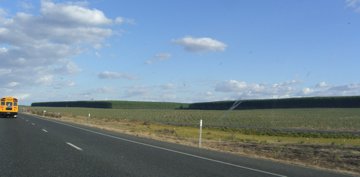
I know one thing about Coeur D’Alene that I didn’t know yesterday when I left home: It’s 1,000 miles from Berkeley, almost exactly. I had broken the trip down into increments — 510 miles to Eugene, another 110 or so to Portland, and then a big jump of 380 to this place — so the enormity of the undertaking didn’t really hit me. Now that we (Pete and I) are here and now that we’ve eaten at the conveniently located Outback Steakhouse, our plan is to get up early and do a 112-mile bike ride. The course is the one used by the Ironman event held here each year in June; Pete’s signed up to do it in 2008, and he wants to get an idea of what the terrain is like. I’m just tagging along — no triathlons in my future that I know of.
Anyway, the drive up from Portland featured more spectacular Western landscape. Today’s drive started east on Interstate 84, up through the Columbia River Gorge and past the Bonneville, Dalles and John Day dams. The gorge is monumental and ought to be seen at less than 70 mph. A good 125 miles east of Portland the highway leaves the immediate riverside and you finally get a look at what lies beyond the edge of the gorge. Unlike the wet, green country around Portland, this is the dry West. But undulating and mountainous, in the distance, and beautiful.
Before we turned north across the Columbia, we saw what I took to be some artificially built mounds in the distance. Ahead of us on our right, there was a massive stand of trees. A massive tree farm, actually. And it went on and on for miles. The mounds in the distance were actually farmed forests. The trees looked familiar but unfamiliar — a kind of poplar, maybe. Pete saw a couple of signs, one naming the trees in as "Pacific albus" planted in 1999 and the outfit growing them as the GreenWood Tree Farm.
It’s not clear to me how much land they have planted out there — I’ve seen references that range from 6,000 to 35,000 acres. It’s a big expanse. Checking online, I see that GreenWood has developed Pacific albus, a poplar hybrid, as a source of commercial hardwood and has a deal with another Northwest forest products company to build a sawmill near the tree farm we passed. You could say lots about this kind of farming: that it’s a result of so much of the wild old forests in the region being cut down; that it spares wild forests, if any, from being cut down; that it’s a really smart way to answer a demand that’s only growing. I still have to say, though, it was odd to see these immense stands of trees so clearly meant for nothing other than cutting and milling.
Technorati Tags: oregon
